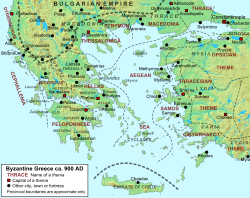Aegean Sea (theme)
| Theme of the Aegean Sea θέμα τοῦ Αἰγαίου Πελάγους |
|||||
| Theme of the Byzantine Empire | |||||
|
|||||
| Map of Byzantine Greece c. 900 AD, with the themes and major settlements. | |||||
| Historical era | Middle Ages | ||||
| • | Established | 843 | |||
| • | Fourth Crusade | 1204 | |||
| Today part of |
|
||||
The Theme of the Aegean Sea (Greek: θέμα τοῦ Αἰγαίου Πελάγους, thema tou Aigaiou Pelagous) was a Byzantine province in the northern Aegean Sea, established in the mid-9th century. As one of the Byzantine Empire's three dedicated naval themes (Greek: θέματα ναυτικᾶ), it served chiefly to provide ships and troops for the Byzantine navy, but also served as a civil administrative circumscription.
The theme has its origins in the late antique civil province of the "Islands" (Latin: Insulae; Greek: Nήσοι), which encompassed the islands of the southeastern and eastern Aegean up to Tenedos. The term "Aigaion Pelagos" appears for the first time as an administrative circumscription in the early 8th century, when seals of several of its kommerkiarioi (customs officials) are attested. One seal, dated to 721/722, even refers to an official in charge of all the Greek islands, possibly implying an extension of the old province over the islands of the northern and western Aegean as well. Militarily, the Aegean islands came under control of the Karabisianoi corps and later of the Cibyrrhaeot Theme during the 7th and 8th centuries. From the late 8th century, however, two separate commands appear in the Aegean: the droungarios of the Aegean Sea (Aigaion Pelagos), apparently controlling the northern half, and the droungarios "of the Twelve Islands" (Dodekanesos) or "of the Gulf" (Kolpos), in charge of the south. The latter command eventually evolved into the theme of Samos, while the former evolved into the theme of the Aegean Sea, encompassing both the islands of the northern Aegean as well as the Dardanelles and the southern coasts of the Propontis. The theme of the Aegean Sea must have been created in 843: its governing strategos does not appear in the Taktikon Uspensky of 842/843, which still lists the droungarios, but he is elsewhere attested as being active at Lesbos in 843.
...
Wikipedia

